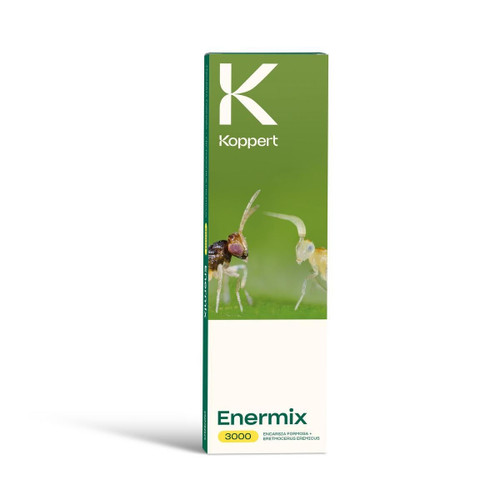White Fly
Whiteflies are not true flies, but belong to the order Hemiptera (true bugs). Together with aphids and scale insects, they belong to the division Sternorrhyncha. The whiteflies form the family Aleyrodidae. The most common species are the greenhouse whitefly, Trialeurodes vaporariorum, and the tobacco whitefly, Bemisia tabaci. Both are widespread, and are broadly comparable in outline.
-
 Swirski-Mite Ulti-Mite Sachets
Swirski-Mite Ulti-Mite SachetsSwirski-Mite Ulti-Mite Sachets (Amblyseius swirskii) — Predatory Mite for Thrips, Whiteflies &…
Use For Thrips, White Fly, Broad and Russet Mites, Two-Spotted Spider Mites, Flat MitesSpecies A. swirskii$35.99 -
 Swirski-Mite
Swirski-MiteSwirski-Mite (Amblyseius swirskii) — Predatory Mite for Thrips, Whiteflies & Pest MitesSwi…
Use For Thrips, White Fly, Broad and Russet Mites, Two-Spotted Spider Mites, Flat MitesSpecies A. swirskii$155.22 -
 Swirski-Mite PLUS Sachets
Swirski-Mite PLUS SachetsSwirskii-Mite PLUS Sachets (Amblyseius swirskii) — Predatory Mite for Thrips, Whiteflies &…
Use For Thrips, White Fly, Broad and Russet Mites, Two-Spotted Spider Mites, Flat MitesSpecies A. swirskii$84.36 -
 Horiver Sticky Traps
Horiver Sticky TrapsHoriver Yellow Sticky Traps — 10-Pack (3.94" x 9.84") Monitoring & Trapping for Flying Ins…
Use For Aphids, Leaf Miners, Whiteflies, Thrips, Sciarids$10.69 -
 Isarid Mycoinsectide
Isarid MycoinsectideGeneral information When to use Isarid? Isarid™ works best in a pest management program de…
Use For whiteflies, aphids, thrips, psyllids, mealybugs, leaf hoppers, plant bugs*, weevils*, grasshoppers*, Mormon crickets, locust, beetles, mites, bagrada bugs, lygus bugs, and fungus gnats*. *Not Registered for Use By California$231.70 -
 Capsanem (OMRI)
Capsanem (OMRI)Capsanem — Steinernema carpocapsaeCapsanem contains infective third-stage juveniles (L3) of St…
Use For Caterpillars, Coleoptera, Flies, Fungus GnatsSpecies S. carpocapsae$40.20 -
 Enermix
EnermixEnermix (Encarsia formosa + Eretmocerus eremicus) — Parasitic Wasp CardsEnermix contains a mix…
Use For Whitefly Spp.Species Eretmocerus eremicus & Encarsia formosa$51.74 -
 Knowing and Recognizing Book
Knowing and Recognizing BookGet the growers’ guide to biological crop protection Knowing and recognizing – The …
$201.27 -
 Horiver Sticky Traps (Yellow, Large)
Horiver Sticky Traps (Yellow, Large)Horiver Yellow Sticky Traps — Large Cards (9.84" x 15.75") - Monitoring & Trapping for Fly…
Use For Aphids, Leaf Miners, Whiteflies, Thrips, Sciarids$32.76 -
 Limonica
LimonicaLimonica (Amblydromalus limonicus) — Predatory Mite for Thrips & WhitefliesLimonica bottle…
Use for Thrips, WhiteflySpecies Amblydromalus limonicus$165.91
More Information about White Fly
[↑ Back to Top]Damage symptoms
The larvae of whitefly need a lot of protein for growth, and thus consume a large quantity of plant sap. This contains a high proportion of sugar, and the excess is excreted as honeydew, with larger larvae expelling large quantities. The damage that whiteflies cause to a crop is the result of sucking out the sap from the plant leaves and secreting honeydew. This can have the following consequences:
- If the population is very large, feeding on plant sap can affect the physiology of the plant, as a result of which growth is stunted. In full sunlight, leaves can wilt and fall. Such leaf damage can in turn influence the development of fruit and lead to a reduction in yield.
- The honeydew deposited on fruit makes it sticky. Dirt adheres to the fruit, and the growth of sooty moulds (Cladosporium spp.) is encouraged, making it unsuitable for sale. In serious cases the fruit will rot. Sooty moulds also develop on the leaves, reducing photosynthesis and transpiration.
- Viruses can be transmitted.
- The consumption of plant sap and secreting of honeydew by whiteflies reduce the aesthetic value of crops. This is particularly important in ornamentals.

